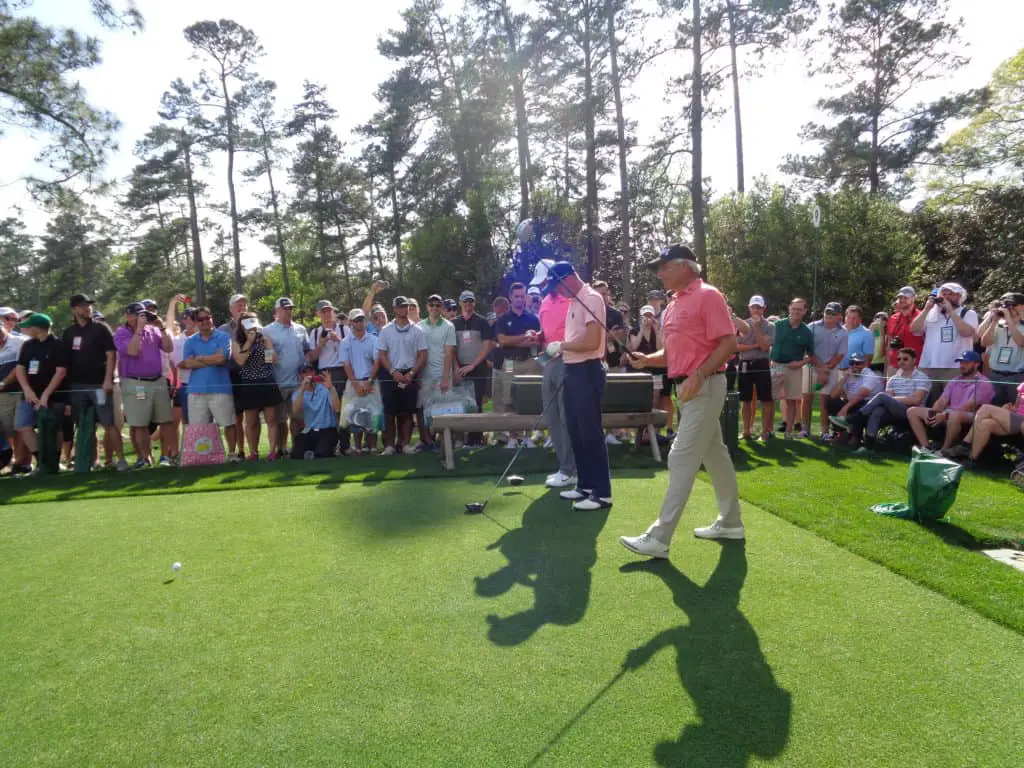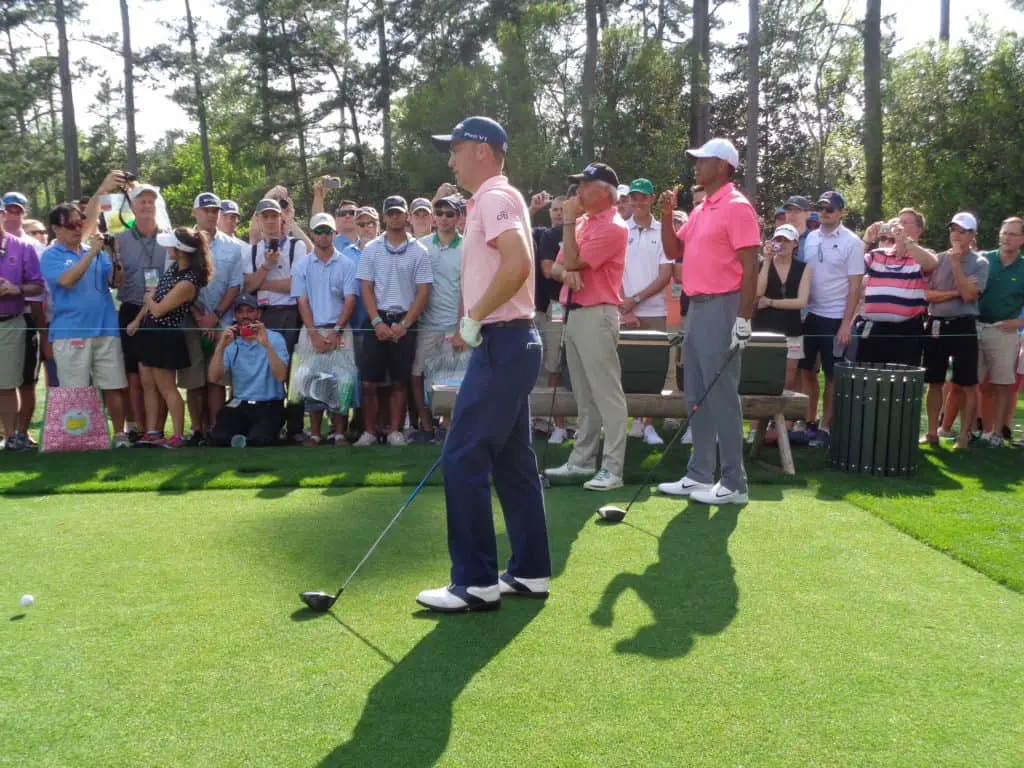Do you lack consistency?
Do you lack power?
Do you ever wish you could play solid golf and hit shot after shot that is solid and flies where you are looking?
One of the areas many golfers struggle with is tension in the golf swing. You can watch video after video about swing path, club face control and speed, but ultimately if you have too much tension in your swing, you are going to struggle.
The tension seems to arise at the worst times as you might have an increased level of stress or anxiety on the first tee, late in a match or when you really want to golf well.
Personal Experience: Tension is something I play close attention to in my golf swing. When the pressure is on and you really want to hit a good shot, taking the extra breath and trying to stay tension free is even that much more important. We have to allow our body to make the swing and try to reduce the tension as it can absolutely destroy the golf swing. Tension will impact quality of contact, swing speed and direction all at the same time.
Tension Free Golf Swing (Why and How)
Below, we will dive into two topics:
- Why is a tension free golf swing important
- How to achieve a tension free golf swing

Why is a tension free golf swing important?
Golf is a game where the golf club travels anywhere from 80 to 130 miles per hour with the driver. If you start to tense your muscles up too much during the swing, you will lose speed and control.
Ultimately, the reason you need a tension free swing is that it helps with the following:
- Speed
- Control
- Producing under pressure
Bottom line…the best golf swings happen when the body is able to swing the club freely without tension. Think of Fred Couples, he looks very smooth over the ball. This doesn’t mean he isn’t swinging fast, but he looks completely in control and has a wonderful tempo.
Many golfers have two false feelings or myths in their swing:
- They are going to swing hard for additional speed.
- If they slow down and control the club face, they will hit the ball straighter.
Speed
The reality is that the key to additional speed is swinging faster not harder and faster begins with a free flowing swing free of tension.
Control
The second piece is that as the golfer starts to try to hit the ball straighter, they will often tense up and actually hit a worse shot either as a result of poor contact or too much tension causing a loss of control of the club face.
Producing Under Pressure
Finally, when you want to play your best golf is when you might be feeling the most amount of anxiety or stress over the golf ball. As a result the muscles tense up and you are not able to perform at your peak ability.
If you are golfing with a good friend, out for a leisurely round, you will more than likely hit the ball solid. However, get on the first tee or an important hole with someone that you haven’t golfed with before, and it can almost feel like an out of body experience.

How to achieve a tension free golf swing?
There are some key steps to establishing a tension free golf swing:
- Keep a soft feeling in your arms
- Start your backswing with your body and arms
- During transition allow the arms to fall freely
- Keep your body moving through impact
Keep a soft feeling in your arms
If you are gripping the club really tight and then rip the arms back and through, you are going to struggle with the golf swing. Instead, keep a soft feeling in your arms on the backswing and most importantly in transition. Overall, the arms have to be able to move and they will actually move faster and generate more speed, the more relaxed your arms are.
The battle for most golfers is it might feel slower because they equate swinging harder with swing faster. The proper sequencing in the swing, has the body get ever so slightly ahead of the arms and then arms zip through the swing with very little tension in the arms.
Start your backswing your body and arms
A second key is to start your backswing with your arms and body. Too many golfers will only move their arms, creating extra tension and lacking a complete turn in the backswing. This leads to a pulling down of the arms, increasing the tension in the golf swing.
Instead, imagine that you are holding a medicine ball and want to throw the ball behind you. You would want to use your body and arms. If you only used your arms, you wouldn’t be able to throw it as far and instead might actually hurt your back. You would probably even engage your legs a bit as you use your entire body to get the ball going backwards.
This throwing motion behind you, will set you up with a complete turn in the backswing and allow you to transition into your downswing with soft, free flowing arms.
During transition allow the arms to flow freely
Now that you are at the top of your backswing, feel like for a split second your keep your arms up as your body starts to move down and through the shot. The arms will naturally respond, keeping the tension out of your golf swing.
The best instructor at teaching this move is George Gankas. Of course, he spends a ton of time working on the proper pivot and leg work, but this tension free start to the downswing allows the club to fling through the hitting zone with plenty of speed.
I recently rediscovered this feel in my swing and it has added another 5-10 yards of zip with my drive and I find myself flying the occasional green with some iron shots when I hit it just right from a sequencing and tension free strike of the golf ball.
Keep your body moving through impact
As soon as the body stops, you end up flipping your hands and hitting poor shots. If you are going to have the feeling of leaving your arms back for a split second during transition, it is essential to keep turning through the ball and all the way to the top of your follow through.
When executed correctly, the accuracy from the club face stability and the overall speed produced is simply impressive and feels like something you can do over and over again.
I have found when I start within myself my start lines and overall distance is the best I have experienced in over 30 years of playing golf.
Gone are the days of trying to manipulate the club face through impact and a tension free golf swing with a moving body back and through the shot are now my key swing thoughts.

BONUS TIP
Think about smacking the ball with the back of your left hand. You can control your club face by controlling the back of your left hand. This keeps your right hand from taking over and flipping through the shot. A tension free swing with soft arms with the back of your left hand smacking the ball is a solid feel to play golf with it!
The Keys To Any Golf Swing
Ultimately, the golfer is focused on three fundamentals in the golf swing:
- Are they able to control the low point of the swing?
- Are they able to control the start line and curve of the ball?
- Do they have enough distance to play the course?
When a golfer is able to answer yes to all of the three questions above, they are on their way to shooting some impressive scores, assuming they have a decent short game. The key to consistent golf starts with the tension free golf swing and can be assessed using the three keys listed above.
What’s Next
Head to the driving range and focus on the 4 keys on how to achieve a tension free swing:
- Keep a soft feeling in your arms
- Start your backswing with your body and arms
- During transition allow the arms to fall freely
- Keep your body moving through impact
Recently, I helped one of my senior students with this feeling on the backswing of throwing the medicine ball back and suddenly his driver started flying an extra 15-25 yards immediately. He was failing to get a full turn, leading to tension in the swing and trying to flip the club through impact.
It was a thing of beauty when those drives started to take off and the joy in his game returned. Go ahead and try out those 4 keys above and start having fun again. Head to the course with confidence that you are going to hit the ball like you want.
Take Action – What You Can Do Today to Get Better
What does this mean for you? I believe in the following recipe to get better:
1 – Improve your motion in the golf swing by identifying a golf instructor. Here are some options:
Here is a list of golf instructors that we have reviewed:
2 – Train to swing faster and improve your swing speed. Here are some options:
Looking to gain more Speed and Distance in your swing. Two Options:
3 – Understand course strategy and work to break through your next barrier. Here is a series on breaking through:
We have provided guides on how to break 100, 90, 80 and 70. Check out more below, if interested.
4 – Practice Frequently
Did you know that I build a golf simulator in my garage and have played over 500 rounds of golf on my SkyTrak system? It has been a game changer and one worth checking out. Here are some of my other posts on golf simulators frequently asked questions:
- Is a Golf Simulator Worth It?
- How to Build a Golf Simulator?
- What is the Best Golf Simulator?
- Golf Simulator Accessories?
- How to Build a Golf Simulator for under $7000
- Top 11 Reasons to Buy a SkyTrak
- How to Build a Golf Simulator for Under $1000
- Why Build A Golf Simulator?
- What Space is Needed?
- Can A Golf Simulator Improve My Game?
- How Much Does A Golf Simulator Cost?
- Don’t Forget to Check out our 15 best golf swings of all time.
